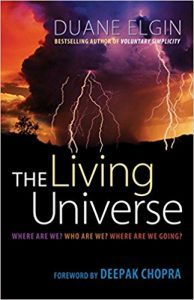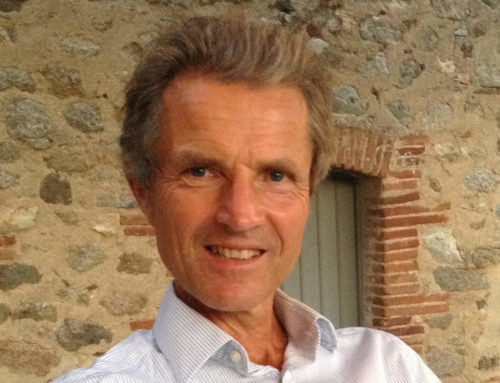Book review by David Lorimer
THE LIVING UNIVERSE
Duane Elgin
Berrett-Koehler, 2009, 230 pp.
ISBN: 978-1-57675-969-1
Duane Elgin is author of Voluntary Simplicity and Awakening Earth – here he sets out his understanding of a living rather than a dead universe and its implications for how we see ourselves and our future. It is based on three fundamental questions: Where are we? Who are we? Where are we going? The Renaissance view incorporated the idea of an Anima Mundi and indigenous cultures assume an animistic universe, but since the 17th century the West has been dominated by the mechanistic metaphor implying a deanimated Nature and a fundamentally non-living and purposeless universe. Anthropomorphism is often criticised, but, as Rupert Sheldrake suggests, the modern scientific picture is in fact mechanomorphic – we project onto the universe our mechanistic understanding and explain ourselves in terms of this.
Duane defines a living universe as ‘a unified and completely interdependent system that is continuously regenerated by the flow-through of phenomenal amounts of life energy whose essential nature includes consciousness or a self reflective capacity that enables systems at every scale of existence to exercise some freedom of choice.’ (p. 12) He argues, correctly in my view, that how we see ourselves is a critical cultural factor and that the idea of the living universe will create a new sense of relationship with the Earth and the universe. He provides a very useful table on pp. 30-31 contrasting a dead with a living universe. In this view, consciousness is a living field of life energy providing reflective capacity, and we are fundamentally spiritual beings having a bodily experience. Ethically, because everything is alive and interconnected, ‘whatever I do to the world I ultimately do to myself.’ Duane then discusses the nature of the living universe in more detail, including the flow of energy, continuous regeneration and sentience throughout.
In the 1970s, Duane was involved in the government-sponsored SRI parapsychology programme, and this gave him the opportunity to explore his intuitive connection with some of the experimental apparatus. He calls this ‘cosmic feedback training’, implying an empathic connection with the universe and an extension of consciousness far beyond the range of physical senses. The effects are sometimes very subtle, and the fundamental relationship is not one of dominance, but rather participation. This gave him a felt sense that there is a field of consciousness pervading the universe, which is consistent with the definition of a living universe already cited.
The second part explores spiritual traditions and the idea that spirituality is intimacy with a living universe. He also looks at the idea of the Mother Universe as the ultimate beyond description, articulated variously as God, Brahman and Tao. He sees our identity as embodying three paradoxes: unity with diversity, knower and known, being and becoming. Consistent with insights from modern physics, his understanding of reality is one of vibrations, frequencies and harmonies, and the body is a biodegradable vehicle for acquiring soul-growth; when we leave the world, we take away ‘the distilled knowing-essence of our passage to life’ – I think this is spot on. He sums this up as follows: ‘at the heart of life is a simple task: to become intimate and forgiving friends with ourselves and to grow ourselves as a stream of light, love, music and knowing. (p. 113)
The third part of asks where we are going. At one level, life seeks to connect with itself, know itself and grow in an evolutionary process to higher levels of self-organisation. This also suggests the task in front of humanity, which Duane sees as a heroic journey from the limited thinking self through reflective and oceanic to what he calls flow consciousness characterised by the toroidal form as we awaken to a conscious living universe. He suggests a further collective scheme from separation to initiation to communion, similarly to Thomas Berry. The supreme test of our time is to ‘learn to live in balance with the Earth, in peace with one another, and in gratitude to the living universe.’ (p. 139) However, this involves dealing with what he calls ‘adversity trends’ as our ecological, economic, political, cultural, psychological and spiritual systems enter into a crisis of adaptation, quite possibly bringing about a world scale systems crisis, which we are already beginning to see, as it becomes increasingly clear that our current systems are radically inadequate.
The last part sets out a blueprint for action in terms of co-creating our story of awakening, cultivating reflection and reconciliation, living simply and sustainably, creating new kinds of community, and becoming media conscious citizens of the Earth. The current breakdown is an opportunity for breakthrough, but this is by no means guaranteed as we can either ‘pull together in creative cooperation or pull apart in profound conflict’, only to have a totalitarian order imposed from above and maintained by violence and force. As I was reading this book, it occurred to me that many of the vital words in this respect begin with r: rebirth, renewal, renaissance, regeneration, restoration, reconnection, reconciliation, reciprocity and refinement. The value of this book lies in its setting out the necessary transformative vision for a positive future, but also in spelling out exactly how we can help bring this about.
Buy The Living Universe here.

